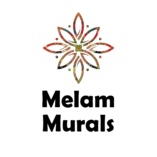The Unique Techniques of Kerala Mural Art
Creating a Kerala mural painting is not a task that can be rushed. It is a slow, meditative process that blends patience, skill, and deep rooted tradition. These paintings have their roots in ancient temple walls, where artists used natural pigments made from minerals, plants, and charcoal. Every artwork was made with a sense of devotion and purpose. But as times changed, so did the surface and medium. Today, these beautiful paintings are often created on canvas using acrylic or oil based paints that offer both brightness and durability, while still staying true to the original style.
Where the Journey Begins
The process begins long before the brush touches the canvas. First, the canvas is stretched, prepared, and primed. The artist then carefully sketches the layout, placing each character and element with perfect balance. Kerala murals are usually inspired by mythological stories, divine figures, or scenes from nature. The planning stage is important because every mural is more than just a painting, it is a visual story.
Once the outline is ready, the artist begins adding colour, slowly, layer by layer. Traditional shades include deep reds, soft yellows, warm browns, earthy greens, and natural whites. These colours are applied with care, building depth and character with each stroke. The choice of colour is not random—it follows a method and a mood that fits the story being told.
What Makes Kerala Murals Unique
One of the most striking features of Kerala mural paintings is the attention to detail. From the curve of a smile to the patterns on a costume, every small element is drawn with care and meaning. The figures often have expressive eyes, flowing clothes, and calm yet powerful body language. These details are not just for beauty—they help bring the story and its emotions to life.
The painting style is graceful and balanced. Most faces are shown in profile, eyes are wide and defined, and postures are natural and elegant. The background often includes floral borders, clouds, animals, or divine symbols, each adding a layer of meaning to the main theme.
From Temple Walls to Modern Interiors
In earlier days, these artworks were painted directly onto the walls of temples and royal buildings. But with the shift to canvas, mural paintings from Kerala have become easier to transport and display in homes, offices, and hotels. This change has made the art more accessible while preserving its beauty and spirit.
Today’s artists have more freedom to work in different sizes and styles. Large murals are used in hotel lobbies, resort halls, or temple rooms. Smaller versions can decorate living rooms, reading corners, or office walls. Whether the subject is a peaceful Krishna under a tree or a fierce form of Shiva in dance, each mural becomes a timeless centerpiece.
Fitting into Traditional and Modern Decor
One of the reasons Kerala murals are gaining popularity in interior design is their ability to blend with both classic and modern spaces. Their earthy tones, elegant lines, and spiritual themes bring warmth and depth to any room. Whether your decor includes wooden antiques or sleek modern furniture, a mural adds a unique cultural charm that stands out.
They are more than decoration. These artworks tell stories and spark conversations. Guests notice them. Children ask questions about them. They become part of the space in a quiet, powerful way.
Bringing the Art Home
At Melam Murals , we create these artworks using oil colours on high quality canvas. Each piece is painted by hand, staying true to the traditional style while making it easy to frame and install. These canvas murals are durable, portable, and need very little maintenance.
Whether you are a lover of Indian art or someone simply looking to add some soul to your space, Kerala murals offer a beautiful and meaningful choice. You do not need a temple wall to enjoy this art. You can bring home a ready to frame painting that reflects the spirit of Kerala and its storytelling tradition.
If you want to know more about the roots of this art form, the Kerala Tourism website has a helpful article that explains the history and importance of mural paintings in Kerala. It is a good starting point for anyone curious about the culture behind the canvas.
Final Thoughts
Kerala mural painting is not just about colours and shapes. It is a form of devotion, discipline, and deep thought. Every line, every shade, every figure has a reason to be there. It is an art that invites you to pause, reflect, and feel.
So the next time you see a mural, take a moment. Look closely. You might find more than just a painting—you might find a story, a connection, a piece of timeless heritage.
And if you are looking for the best mural paintings in Kerala, we would be happy to help you find the one that speaks to your space and your soul.

Best mural paintings in malappuram, kerala